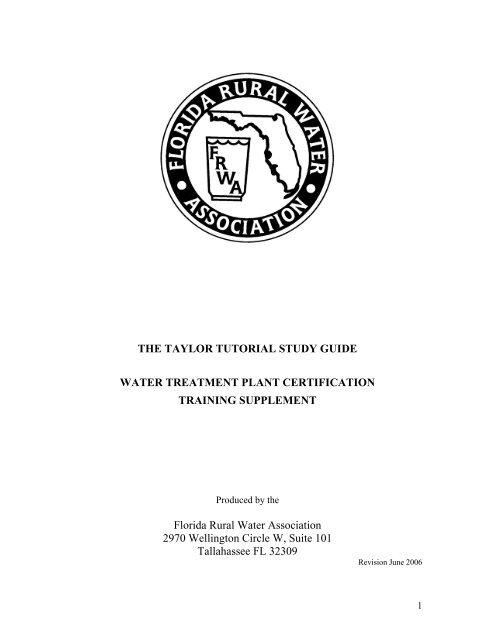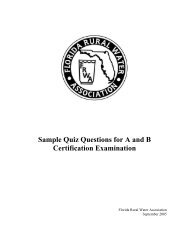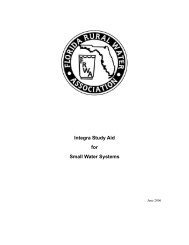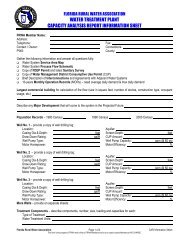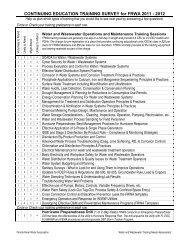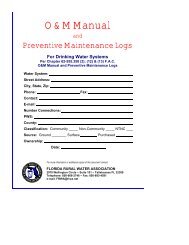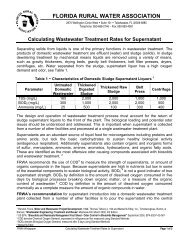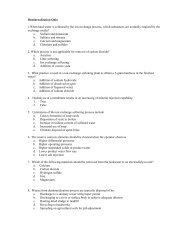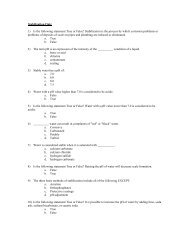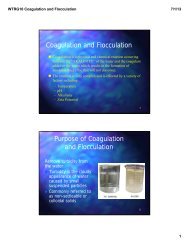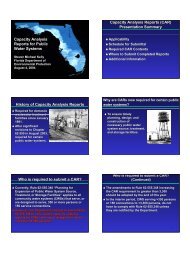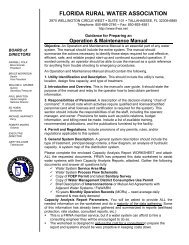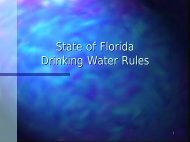The Taylor Tutorial - Florida Rural Water Association
The Taylor Tutorial - Florida Rural Water Association
The Taylor Tutorial - Florida Rural Water Association
You also want an ePaper? Increase the reach of your titles
YUMPU automatically turns print PDFs into web optimized ePapers that Google loves.
THE TAYLOR TUTORIAL STUDY GUIDEWATER TREATMENT PLANT CERTIFICATIONTRAINING SUPPLEMENTProduced by the<strong>Florida</strong> <strong>Rural</strong> <strong>Water</strong> <strong>Association</strong>2970 Wellington Circle W, Suite 101Tallahassee FL 32309Revision June 20061
Introduction to <strong>The</strong> <strong>Taylor</strong> <strong>Tutorial</strong> Study GuideThose preparing for their <strong>Water</strong> Treatment Plant C and D Certification Examination havefrequently sought a concise compilation of treatment facts to help them prepare for theseexaminations. <strong>The</strong> <strong>Taylor</strong> <strong>Tutorial</strong> Study Guide has been successfully used by manywater treatment plant operators for this purpose. <strong>The</strong> <strong>Florida</strong> <strong>Rural</strong> <strong>Water</strong> <strong>Association</strong>has reprinted the guide to assist certification exam applicants in their preparations.This guide was originally compiled by Michael <strong>Taylor</strong>. Mr. <strong>Taylor</strong> is a water treatmentplant operator at the City of Jacksonville Beach <strong>Water</strong> Treatment Plant. He has allowedthe <strong>Florida</strong> <strong>Rural</strong> <strong>Water</strong> <strong>Association</strong> to reprint his work here to assist the many watertreatment plant operators who are preparing for their water treatment plant certificationexaminations. <strong>The</strong> Guide highlights concepts important in the understanding of the watertreatment process. We are very much indebted to Mr. <strong>Taylor</strong> for his excellent work.Small organizational edits have been made to make the Study Guide easier for applicantsto use.<strong>The</strong> <strong>Tutorial</strong> has been organized in sections to conform to the <strong>Florida</strong> <strong>Rural</strong> <strong>Water</strong><strong>Association</strong>’s Small <strong>Water</strong> Systems Training Guide. Operators taking the State of <strong>Florida</strong><strong>Water</strong> Treatment Plant Operator’s Certification Examination are encouraged to use the<strong>Florida</strong> <strong>Rural</strong> <strong>Water</strong> <strong>Association</strong>’s Small <strong>Water</strong> System’s Training Guide as the basic textto assist the operator in applying and understanding the many facts highlighted in the<strong>Taylor</strong> <strong>Tutorial</strong>. <strong>The</strong> Small <strong>Water</strong> Systems Training Guide can be obtained from <strong>The</strong><strong>Florida</strong> <strong>Rural</strong> <strong>Water</strong> <strong>Association</strong>, by calling (850)-668-2746, by visiting the <strong>Florida</strong> <strong>Rural</strong><strong>Water</strong> <strong>Association</strong> WEB site at http://www.fwra.net or by attending a <strong>Water</strong> PlantCertification Training Session hosted by the <strong>Florida</strong> <strong>Rural</strong> <strong>Water</strong> <strong>Association</strong> held atvarious locations around the State of <strong>Florida</strong> beginning 8 weeks prior to the February andAugust State Examinations.Those operators that are responsible for Surface <strong>Water</strong> Plants are strongly encouraged toalso obtain <strong>The</strong> <strong>Florida</strong> <strong>Rural</strong> <strong>Water</strong> <strong>Association</strong>’s Surface <strong>Water</strong> Training Supplementwhich can be obtained through the processes mentioned above. This Training Supplementhas additional detail applicable to Surface <strong>Water</strong> Treatment.2
INTRODUCTION TO THE TAYLOR TUTORIAL STUDY GUIDE ....................... 2WATER SOURCES FOR DRINKING WATER SUPPLY ......................................... 4FLORIDA RULES AND SAFE DRINKING WATER ACT REQUIREMENT FORWATER SYSTEMS.......................................................................................................... 7WELL REQUIREMENTS FOR PUBLIC WATER SYSTEMS ................................. 9WATER STORAGE....................................................................................................... 10CHLORINATION AND DISINFECTION .................................................................. 11COAGULATION/FLOCCULATION .......................................................................... 14SEDIMENTATION ........................................................................................................ 19FILTERS .........................................................................................................................20WATER STABILIZATION .......................................................................................... 21DEMINERALIZATION (MEMBRANE FILTRATION, ION EXCHANGE ANDDIALYSIS) ...................................................................................................................... 22SOFTENING................................................................................................................... 28DISINFECTION AND DISINFECTION BYPRODUCTS......................................... 31BASIC MATH AND CHEMISTRY FOR WATER PLANT OPERATORS ........... 32WATER TREATMENT FUNDAMENTALS.............................................................. 383
<strong>Water</strong> Sources for Drinking <strong>Water</strong> Supply1. Purpose of <strong>Water</strong> Treatment• <strong>The</strong> first priority for operating a water treatment plant is the production ofsafe drinking water, one that is free of harmful bacteria and toxicmaterials.2. <strong>Water</strong>borne diseases are caused by:• Cholera• Dysentery• Gastroeteritis• Giardiasis• Hepatitis• Typhoid• Malaria is not a water borne illness!3. Causes of Impurities in <strong>Water</strong>• Land erosion• Decay of plant material• Airborne contamination• Industrial discharges• Animal wastes4. Causes of Surface <strong>Water</strong> Pollution• People• Nature• Suspended and dissolved organic (plant and animal origin)• Inorganic (mineral) material• Biological – Bacteria & plankton5. Hydrological CyclePrecipitation infiltrates the soil. <strong>Water</strong> drains downward (percolates)below root zone and finally reaches a level at which all openings andvoids in the earths materials are filled with water. This is known as thezone of saturation. Also known as Ground water.6. <strong>The</strong>rmal Stratification of Lakes and Impoundments• Upper layer – Epilimnion (constant temp – warm)• Middle layer – <strong>The</strong>rmocline or metaumnion (Rapid temp decrease)• Lower layer – Hypolimnion (cooler denser water)• Summer: <strong>Water</strong> warm – less dense and stays in upper layer, with nomixing to lower layers• Turn over4
In winter, upper layer cools and becomes equal with lower level of lake.<strong>Water</strong> density is uniform. <strong>Water</strong> is mixed with wind cooling more densewater and sinks and mixes with lower level water.Monomictic – One mixingDimictic – Two mixing; Lakes and reservoirs which freeze over normallygo through two stratifications and 2 mixings cycles per year7. Algae Blooms and PH• Algal blooms are often associated with fluctuations in PH of the water inthe upper layers of a resevoir where blooms occur.• PH is frequently raised from a level near 7 to near 9 or above.• Chlorination efficiency greatly reduced at higher PH levels.• Algae removes carbon dioxide from solution• Converts carbon dioxide into cellular material as algae grows• Carbonate equilibrium (balance) is affected• Under favorable light conditions, in high concentrations of algae growth,PH levels values can rise as high as 9.8• During daylight hours, PH will increase• PH will lower at night• Respiration by algae results in an increase in carbon dioxide in water(lower of PH)• Photosynthesis decreases carbon dioxide in water (increasing PH)• Fluctuations in PH affect both coagulation and disinfection.• Chemicals used to control Algal growths are copper sulfate pentahydrate(bluestone) –algaecide; Treat in autumn• Alkalinity, suspended matter and water temp affect copper sulfate as aalgaecide• Copper sulfate is fully effective when alkalinity is 0-50 mg/l• Alkalinity above 150mg/l, copper sulfate is in-effective8. Nutrients Considerations in Surface <strong>Water</strong> Sources• Phosphate• Nitrate• Organic nitrogen compounds• Nutrient RICH water sources – Eutrophic• Nutrient POOR water sources – Oligotrophic• Eutrophic – acts as a fertilizer and stimulates algae growth• Mesotrophic – Moderate level of nutrients5
9. Problems with Lack of Dissolved Oxygen and low pH• Sulfate is reduced to Sulfide (stinky) causing odor problems• Iron and ManganeseHigh level of dissolved oxygen, iron & manganese is oxidizable andprecipitates into the reservoirs bottom sediments (un-soluble)Low levels of dissolved oxygen, iron and manganese become solubleIron becomes soluble Ferrous stateManganese becomes soluble manganous state10. Types of Contaminants• Organic: Substances that come from animal or plant sources. Organicsubstances always contain carbon. (inorganic materials are chemicalsubstances of mineral origin)• Inorganic: Materials such as sand, salt, iron, calcium salts and othermineral materials. Inorganic substances are of mineral origin, whereasorganic substances are usually of animal or plant origin.• Biological: Bacteria and Virus• Radiological: Radon and Radionuclides11. Ground <strong>Water</strong> Sources• <strong>Water</strong> obtained from Zone of Saturation• Can be protected by confining layers of lime rock and Clay• Artesian Springs are (free flowing because of potentiometric pressure• Typical water sources are Aquifers and UDI Under direct influence ofsurface water6
<strong>Florida</strong> Rules and Safe Drinking <strong>Water</strong> Act Requirement for <strong>Water</strong> Systems1. Definitions• Maximum Contaminant Level (MCL.) <strong>The</strong> highest level of a contaminant thatis allowed in drinking water. <strong>The</strong> MCL is the maximum contaminate levelthat is determined by health effects. MCLs are set as close to the MCLGs asfeasible using the best available treatment technology. To understand thepossible health effects described for many regulated constituents, a personwould have to drink 2 liters of water every day at the MCL level for a lifetimeto have a one-in-a-million chance of having the described health effect.• Maximum Residual Disinfectant Level (MRDL.) <strong>The</strong> highest level of adisinfectant allowed in drinking water. <strong>The</strong>re is convincing evidence thataddition of a disinfectant is necessary for the control of microbialcontaminants.• Maximum residual disinfectant level goal (MRDLG). <strong>The</strong> level of a drinkingwater disinfectant below which there is no known or expected risk to health.MRDLGs do not reflect the benefits of the use of disinfectants to controlmicrobial contaminants.• Action Level (AL) <strong>The</strong> concentration of a contaminant which, whenexceeded, triggers treatment or other requirements which a water system mustfollow. Non-Detects (ND) - laboratory analysis indicates that the contaminantis not present.• Treatment Technique (TT) <strong>The</strong> required process intended to reduce the levelof a contaminant to acceptable levels.2. Regulated Inorganic Compounds• Nitrates and Nitrite (indicators of fecal contamination)Nitrite = 1.0 mg/lNitrate = 10.0 mg/l• Action Levels for Lead and CopperLead = .015 mg/l - 15 ppbCopper = 1.3 ppm3. Secondary MCL’s for Taste and Color• Iron = .3 mg/l• Manganese = .05 mg/l .02 mg/ l initiate flushing (to avoid complaints)7
4. Public <strong>Water</strong> System Classification (PWS)• Public <strong>Water</strong> System DefinitionServes as at least 15 service connectionsRegularly serves an average of at least 25 individuals daily at least 60 daysout of the year.• Public <strong>Water</strong> System Types – Community (CWS) or Non Community <strong>Water</strong>Systems (NCWS)• Community <strong>Water</strong> System (CWS)Has at least 15 service connections used by all year residents orRegularly serves at least 25 all year residents.Examples are cities, mobile home parks, sub-divisions.• Non-Community (NCWS)Serves over 25 different people each day,Examples are stores, plaza’s, gas stations, restaurants, campgrounds andhotels, etc.• Non Transient Non Community (NTNCWS)Serves over 25 of the same people at least 6 months of the year,Examples are schools, hospitals, large business, mostly same peopleeveryday, but don’t actually live thereMust meet the same requirements as community water systems• Transient Non-Community <strong>Water</strong> System (TNCWS)Does not regularly serve drinking water to at least 25 of the same personsover 6 months a year5. Some Regulations to Know• THM’s = .08 mg/l or 80 ppb• Fluoride = Primary 4.0, secondary 2.0 (Notification 2.0, violation 4.0)• Flouride Range are: .8 – 1.2 mg/l (optimum range is .8 – 1.2 mg/l)• <strong>The</strong> recommended MCL requirement for any known carcinogens = 0• Sodium levels in water should be below 20 mg/l• <strong>The</strong> Minimum Free Chlorine Residual is 0.2 mg/l• 4 log removal = 99.99% removal for Surface <strong>Water</strong> Filtration for Viuses• 3 log removal = 99.9 % removal for Surface <strong>Water</strong> Filtration for Giardia8
Well Requirements for Public <strong>Water</strong> Systems1. Setback Distances• Minimium set back, 200 ft from septic tank over 2000 flow• Minimum set back, 100 ft from septic tank under 2000 flow2. DEP Well Construction Requirments• Well pad 6’x6’x4’ concrete sloped away from the casing• Casing must extend 12 inches minimum above concrete slab3. Well Operations Definitions• Static level – Level of water when pump is not operating• Pumping or Dynamic Level – Level of water when pump is operating• Draw down – Drop of water level when water is pumped from well• Pumping – Static = Drawdown4. Well Operation Considerations• Well pump packing gland lubrication – <strong>Water</strong> (aprox one drop per second)• Well casing must be disinfected5. Well Pump Types• Submersible• Centrifugal• Turbine6. Locating a Well• Vulnerability is the most important factor to consider in locating a well sitefrom the health point of view• A well is acidized in order to increase yield• <strong>The</strong> drawdown in a well is measured from the static water level to thepumping water level• If volatile organic chemicals (VOC’s) are detected, sampling must then beconducted quarterly9
<strong>Water</strong> Storage1. Types of <strong>Water</strong> Storage Tanks• Gravity or elevated• Ground Storage• Hydropneumatic2. Elevated or Gravity Tanks• Less variation in pressure• Large storage capacity• 140 ft tank provides 60psi• .433 x Ft = psi3. Advantages Provided by Gravity Storage Tanks• Less variation in pressure• Storage for fire fighting use• Greater storage to meet water requirement• Greater flexibility to meet peak demands• Use of lower capacity wells (pumping not necessary to meet peak systemdemand)• Sizing of pumps to take better advantage of electric load factors• Reduced on and off cycling of pumps• Tie-in of several wells, each pumping at its optimal rate4. Air Compressors• Must be NSF approved10
Chlorination and Disinfection1. Types of Disinfection• Heat treatment – boil water• Radiation – Ultraviolet – High cost and lack of residual and turbidity• Chemical Treatment – includes:Chlorine – is the most widely used disinfectant in water treatment.Chloramines – Chlorine and ammonia mixed (less effective than Chlorine)BrominePotassium PermanganateOzoneChlorine Dioxide2. Factors Affecting Chlorination• PH – the lower the PH the faster the disinfection• Contact time – chlorine contact with water• Temperature – <strong>The</strong> higher the temperature, the more effective the treatment• Organics – Organics in water consume large amounts of chlorine whileforming unwanted disinfection byproducts such as THM’s and HAA5’s• Presence of Reducing Agents – Hydrogen sulfide, Iron and Manganese3. Types of Chlorine Used in <strong>Water</strong> Treatment• Liquid – Sodium Hypochlorite 5.25% Bleach, 12.5% Commercial• Dry Powder – Calcium Hypochlorite 65 – 70% (HTH)• Gas Chlorine – 150lb and 2 ton cylinders – 100% available• Gas Chlorine Lowers PH• Gas Chlorine – Formation of Hypochlorous acid (more effective)• Hypochlorination – Raises PH4. Properties of Gas Chlorine• Greenish – Yellow Gas and is 2.5 times heavier than air• Expands 450 times from liquid to gas• Containers are 150 lb cylinders or Ton containers:• Containers are welded steel tanks with a chlorine capacity of 2000 lbs and aloaded weight of as much as 3650 lbs.• Stamped with serial number, tare weight and date of most recent hydro test.3 fusible plugs on each end and are designed to melt between 158 deg F and 165deg F11
5. Liquid Chlorine 100% Solution• Amber in color• Is about 1 ½ times heavier than water• Seldom seen as a liquid because it boils (converts to gas) at about -30 deg cen• 1 pound or about 11 fluid ounces of liquid chlorine yields aprox 5.4 cubic feetof 100% chlorine gas.6. Liquid Chlorine Solution (Sodium Hypochlorite Solution)• Concentrations of 5 to 15% chlorine• More expensive than chlorine Gas• Easier to handle than chlorine Gas or Calcium Hypochlorite• Very corrosive• Hydrogen is given off as a by-product7. Calcium Hypochlorite Solid• Contains 65% available chlorine• Dissolves easily in water• Available in granular, powdered or tablet form• Corrosive• Strong odor• Must be kept away from organic and petroleum products• Can generate enough heat to cause fire or explosion8. Chloramines• Formed when water containing chlorine and ammonia are mixed• Produces fewer disinfection by products• Chloramine is a weak disinfectant• Much less effective against viruses and protozoa• Best as a secondary disinfectant to prevent bacterial regrowth• Nitrogen Trichloride is the only detrimental reaction formed at a PH below 5• Chlorine reacts with ammonia to form Chloramines and the chloraminesproduce a combined chlorine residual.• Chlorine reacts with nitrogenous compounds to form Chloramines.• When people complain about a strong chlorine odor in the water, it’s oftendue to a chloramine buildup.9. Chlorine Facts that Every Operator Should Know• Liquid Chlorine - Greenish – Yellow Gas• Chlorine is 2.5 times heavier than air• Chlorine expands 450 times from liquid to gas12
• Chlorine demand increases when organic matter increases• Fusible Plugs melt at 158 to 165 degrees• <strong>The</strong>re are 6 fusible plugs on a two ton chlorine cylinder – 3 on each end• <strong>The</strong>re are 3 fusible plugs on a 150 lbs chlorine cylinder• Gas chlorine – lowers Ph and strips Alkalinity• Gas chlorine increases hydrogen concentrations• Gas chlorine is non flammable• CL2 detectors are located at the lowest point where CL2 tanks are stored• Initial concentration of chlorine applied to new water mains for disenfection is50 mg/l• One volume of liquid chlorine confined in a chlorine cylinder under pressurewill yield about 460 volumes of gaseous chlorine.• Daily consumption of gas chlorine is checked by a platform scale• <strong>The</strong> permissible exposure limit (PEL) for chlorine is .5 ppm• <strong>The</strong> disinfection process is used to destroy or inactivate disease producing(pathogenic) organisms• Disinfection is the selective destruction or inactivation of pathogenicorganisms13
Coagulation/Flocculation1. Coagulation chemicals• Metallic Salts of Aluminum and IronAluminum Sulfate (alum)Ferric SulfateFerrous sulfateFerric Chloride2. Synthetic (manmade) Organic Polymers• Polymers – contain ionizable groups – (carboxyl, amino, sulfonic groups)referred to as polyelectrolytes.• Some polymers lose their effectiveness when used in the presence of achlorine residual• Types of PolymersAnionic Polymers with positively charges groupsCationic Polymers with negatively charged groupsNon-Ionic Polymers with no charge• Cationic polymers are used as both primary coagulant and as a coagulant aid(in conjunction with Alum) when alum is not used as a primary• Cationic polymers have the ability to absorb on negatively charged particles(Colloidal Particles) and neutralize their charge3. Primary Coagulants – Neutralize electrical charges of particles causing clumping• Aluminum Sulfate (Alum)• Ferrous Sulfate• Ferric Sulfate• Ferric Chloride4. Coagulant Aids – Ads density to slow settling flocs and stickiness to preventbreakup of flocs.• Lime (coagulant aid)• Sodium Aluminate• Bentonite (weighting agent)• Clay (weighting agent)• Sodium Silicate (weighting agent)• Various synthetic organic water soluble polyelectrolytes14
5. Purpose of Coagulation and flocculation• Removes particulate impurities• Removes non-settlable solids• Removes color from water being treated• Chemicals cause particles to clump together forming floc• Forms larger heavier settling floc6. Coagulation Process• Chemicals are added causing particles to become destabilized and clumptogether• Alum is the most commonly used coagulant7. Flocculation Process• Particles are gently stirred causing collisions that bind them together to formlarger floc particles.8. Important Facts Concerning Coagulation• When the natural alkalinity in raw water is too low to produce completeprecipitation of alum, addition of lime is often added to ensure completeprecipitation• Lower PH values tend to favor positively charged species which are desirablefor reacting with negatively charged colloids and particulates forminginsoluable flocs• Residual alkalinity in water serves to buffer (prevent PH from changing)• Low alkalinity can cause problems with coagulation• Increase alkalinity with Lime or Soda ash• <strong>The</strong> best PH for coagulation usually falls in the range of PH 5 to 7• Removal of organic compounds with effective coagulation / flocculationreduces the formation of TRIHALOMETHANES after chlorine disinfection9. Non-Settleable Solids or Colloids (Do not settle (easily) and requiretreatment to produce larger particles that settle)• bacteria• Fine clays• Silts10. Coagulation/Flocculation Process15
• <strong>The</strong> purpose of coagulation and flocculation is to remove particulateimpurities, especially non-settlable solids and color from water• Coagulating chemicals cause the particles to clump together• Form larger. Heavier floc and settle out• Chemicals cause particles to destabilize and clump together• Flocculation is gentle mixing motion to cause collisions• Particles are removed by sedimentation and filtration11. Flash Mixing• <strong>The</strong> mixing of coagulant chemicals with raw water• Rapidly mixes and equally distributes coagulant chemicals• Entire process is completed in a very short time (several seconds)• First results are the formation of very small particles12. Primary Coagulants and Coagulant Aids• Primary coagulants neutralize the electrical charge and causes particles toclump• Coagulant aids – Add density to slow settling flocs and adds toughness so flocwill not break up.• Coagulant aids could be called flocculation or sedimentation aids13. Coagulant Chemicals (Metallic Salts)• Aluminum sulfate (alum)• Ferric Sulfate• Ferrous Sulfate• When added to water form chemical action with alkalinity producinginsoluble hydroxide compounds that cause agglomeration to occur• Sufficient chemicals must be added to exceed the solubility limit of metalhydroxide, resulting in floc• Floc formed will absorb on particles (turbity)14. Polyelectrolytes or Polymers (Long chained organic molecules)• Carboxyl• Amino• Sulfonic groups15. Anionic and nonionic polymers16
• Effective in certain applications• As coagulant aids• Filter aids16. Polymer Overdosing• Can result in accelerated head loss buildup• Some polymers lose their effectiveness when used with chlorine residual17. Chemistry of Coagulation• Coagulation is a physical and chemical reaction between the alkalinity ofwater and the coagulant• Lower PH values tend to favor positively charged particles which aredesirable for reaction withnegatively charged colloids and particulates• PH for coagulation is best between 5 – 7• Proper PH must be maintained• Coagulants react with alkalinity• Residual alkalinity in water serves as a buffer ( prevents PH from changing)• Alkalinity can be increased with lime or soda ash18. Mixing Coagulation Chemicals• Must be mixed in as short a time as possible (Several seconds)• Hydrolic mixing• Mechanical mixing• Diffusers and grid systems• Pumped blenders19. Flash mixing• Turbulence in the flowing water mixes the chemicals with the water20. Flocculation• Is a slow stirring process that causes• <strong>The</strong> purpose of flocculation is to create floc of a good size, density andtoughness for later removal in the sedimentation and filtration process• Best size floc ranges from 0.1mm to about 3.0mm21. Filtration Process17
• Direct filtration or Conventional filtration• Detention time = <strong>The</strong> right stirring time, stirring intensity, properly shapedbasin and creating stirring action / movement• Insufficient mixing will result in ineffective collisions (of particles) and poorfloc formation• Excessive mixing may tear apart the flocculated particles after they have beenclumped together• Detention time is required for the necessary chemical reaction to take place• Minimum detention time is between 5-20 minutes for direct filtration• Up to 30 minutes for conventional filtration• Disinfection of water will be affected by poor coagulation – flocculation• Effective coagulation/ flocculation removes natural organic compounds• Removal of natural organic compounds reduce the formation oftrihalomethanes (THM’S) following the use of chlorine for disinfection22. Jar Testing• Use clear plastic beakers instead of glass because temperatures will changeless during the test Important Considerations• Selection of the proper type and amount of coagulant chemicals• Jar testing to determine type and quantity of coagulant• Minimum performed at start of shift or water quality change• Most of the suspended solids are removed in the sedimentation basins• Filtration is the final step in the solids removal process• Coagulation and flocculation should be controlled to improve filtration• Grab samples and turbidity meter (turbidimeter) measures water turbidity• Don’t rely on turbity results as your sole process control, and water qualityindicator• Considerable time for water to travel from the various treatment process (2 to6 hours)• Any change in coagulant dosage at the front and will not be noticed in thefinal finished water quality for 2 to 6 hours• Monitor all indicators in the process to detect poor process performance earlyand initiate corrective action:TurbidityPHTempChlorine demand• Floc quality:A popcorn flake is a desirable floc appearanceA milky appearance or a bluish tint means the alum dose is probably too high18
Sedimentation1. Settling of Larger Size Particles• Sand• Heavy silts• Removed by slowing down flow and allowing simple gravity settling• <strong>The</strong>se are settleable solids2. Sedimentation Considerations• Sedimentation – <strong>The</strong> settling rate of a particle becomes much slower as thetemperature drops. <strong>The</strong> colder the water temperature becomes, the longer theparticle takes to settle out.• When water becomes colder, perform jar tests and adjust coagulant dosage toproduce a heavier floc and thus a faster settling floc.• <strong>The</strong> settled materials from coagulation or settling are referred to as sludge,and slurry refers to the suspended floc clumps in the clarifier. Sometime theterms sludge and slurry are use interchangeably.19
FiltersFiltrationMedia TypeMaximumLoading Rate(GPM/Sq ft)MediaSand 2 Sand, GravelDual Media 4 Sand, AnthraciteDeep Bed (multimedia)(depth > 60”)4+ Sand, Anthracite,GarnetFilter Monitoring• Turbidity Monitoring• 15 min intervals using 0n-line turbidimeters at each filter.• Particle Counts• (particularly effective for Giardia and Cryptosporidium cysts; 4 to 15 μ m range• Filtration Rate• meters for each filter very effective to ensure even flow through each filter• Terminal Head Loss• Terminal Head Loss (difference between static head and operating losses) shouldnot be exceeded to prevent air binding• Filter Wash Rate• Seasonal rate adjustments necessary• Length of Filter RunProlonged filter runs result in compactionDiatomaceous Earth Filtration Process• Precoat (generally 1/16 to 1/8 inch coating withrecycle)• Body Feed (continuous, generally ~ 20 ppm)• Filtration (generally operated up to 25 to 30 psi)• Backwash (5 to 8 minutes and “air bumping is• sometimes incorporated to remove material20
<strong>Water</strong> Stabilization1. Corrosive <strong>Water</strong>• Normally, surface water and ground water have a PH Range of 6.8 to 8.5• High concentrations of Carbon Dioxide is an indication of corrosive water• High Dissolved Oxygen content makes the water corrosive• Cathodic protects metal parts in water against Corrosion• <strong>The</strong> amount of dissolved oxygen in cold water is more than in warm water2. <strong>The</strong> Aeration Process• removes undesirable gases such as Hydrogen sulfide and Carbon dioxide• Oxidizes metals such as iron and manganese to insoluble compounds thatprecipitate• Aeration removes volatile organic compounds• Aeration unites must be screened and sealed• Aeration (Oxidation) followed by filtration is used to remove high ironcontent; Ferrous is the most soluble form of iron in water and is oxidized• Since Aeration adds oxygen to the water it will be corrosive3. Chemical Oxidation• Potassium Permanganate – Removes taste and odor from water by oxidation• Also used in Iron / manganese treatment to oxidize any remaining iron andmanganese after chlorination. Oxidizes iron & manganese to insoluble oxides.• Chlorine – removes taste and odor from water by oxidation4. Causes of Foul Taste and Odor Problems in <strong>Water</strong> (more noticeable in warmwater)• Iron and Manganese Slimes• Algea• Hydrogen sulfide5. Red <strong>Water</strong> Complaints• May be caused by corrosive water (Low PH) or iron bacteria in the water.• Corrosive water will create iron bacteria by attacking iron water main piping.• Addition of caustic to raise PH will help eliminate the corrosive watercondition.. Maintaining a good free chlorine residual will eliminate ironbacteria and red water complaints.• Chlorination will oxidize iron creating rust and will aggravate dirty watercomplaints. Maintaining a good flushing program of the water mains isanother way to control red water complaints.21
Demineralization (Membrane Filtration, Ion Exchange and Dialysis)1. Source <strong>Water</strong> for Demineralization Plants• Most of the earths water supply is saline (high in dissolved minerals)• Demineralization is the process that removes dissolved minerals (salts)• Salts are inorganic• Total Dissolve Solids (TDS) is a measure of the mineral content of water• Minerals commonly found in nature consist of positive metallic ions(calcium, sodium) are bonded to negative ions (chloride, sulfate, carbonate)2. Source <strong>Water</strong> Classifications• TDS Limits:• Fresh water – less than 1000mg/l TDS• Brackish – 1000 – 10,000mg/l TDS (not used because of high mineral taste)• Seawater – 35,000mg/l TDS (too expensive to process due high TDS)3. Methods of Demineralizing <strong>Water</strong>• Freezing or distillation (phase change)Reverse osmosisElectrodialysis• Ion exchange (non phase change)• Demineralization is primarly used to remove dissolved inorganic materials• Some systems may also remove suspended solid/materials, organic material,bacteria and viruses4. Reverse Osmosis Process• Reverse osmosis – defined as the passage of a liquid from a weak solution to amore concentrated solution across a semipermeable membrane. <strong>The</strong>membrane allows passage of the water (solvent) but not the dissolved solids(solutes)• Reverse Osmosis Operation:Concentrate is forced through a membrane to yield a less concentratedsolution.• <strong>The</strong> two types of semi-permeable membranes that are used most often fordemineralization are cellulose acetate and thin film composites.Reverse Osmosis operated at a pH of 5.5 - Low pH is maintained so mineralswill pass thru membrane; Demineralized water is called Permeate• Recovery – defined as the percentage of feed flow which is recovered asproduct water.22
• <strong>The</strong> term flux is the expression used to describe the rate of water flow throughthe semipermeable membrane• Flux is expressed in GPD – Gallons per day per square foot of membranesurface or in grams per square centimeter• Most reverse osmosis systems will require periodic cleaning dependent on theaverage membrane flux rate of the system• Feedwaters are never pure and contain dissolve organic and inorganics,bacteria, algae and other potential foulants. Deposits can grow on themembrane surface and hinder water flow through the membrane.5. Reverse Osmosis/Mineral Rejection• Mineral rejection – <strong>The</strong> purpose of demineralization is to separate mineralsfrom water: called mineral rejection.• Higher mineral concentration increases the osmotic pressure• Rejection improves as feed pressure increases.• Typical rejection for most commonly encountered dissolved inorganics isusually between 92-99%• Most demineralization (RO) plants require use of a membrane with highrejection rates (95%)• Reverse osmosis operation Feedwater temperatures has a significant effect onmembrane performance, as temperature of feedwater increases, flux increases7. Hydrolysis in Reverse Osmosis Systems• Cellulose acetate membranes are subject to long term failure called hydrolysisof the membrane which will breakdown into cellulose and acetate acid• Hydrolysis results in lessening of mineral rejection capability. As themembrane hydrolyzes, both the amount of water and the amount of solute thatpermeate the membrane increase and the quality of the product deteriorates• Hydrolysis is accelerated by increased feed temperature and pH• Slightly acidic PH (5 – 6), lowers hydrolysis rate as do cooler temps• Hydrolysis is at a minimum at a PH of about 4.7; standard practice is to injectsulfuric acid to adjust PH to 5.5• Acid is added and pH is adjusted during pretreatment to lengthen the life ofcellulose acetate membranes and to slow hydrolysis23
7. Membranes in Reverse Osmosis Systems• <strong>The</strong> 3 types of Membranes are: Spiral wound, Hollow fine fiber and Tubular• Pre-treatment of feed water removes turbidity and suspended solids to protectthe membrane and ensure maximum efficiency• Pretreatment prevents scaling or fouling of membrane• Disinfection is used to prevent biological growth• Cartridge filters – function only as a particle safeguard, not as a primaryparticle removal device• Turbidity to cartridge should be no greater than (1) one NTU• Sodium hexamethaphosphate is sometimes added as precipitation inhibitorrepresses both calcium carbonate and calcium sulfate scaling8. RO Plant Operation• Pretreatment of source water• <strong>Water</strong> to be mineralizedis pressurized by high pressure feed pumps to the ROpressure vessel membrane assemblies• Membrane assemblies consist of a series of pressure vessels• Typical operating pressure for brackish water varies between 150 – 400psi• Demineralized water is called Permeate• Reject is called Concentrate• Recovery rate is controlled by increasing feed flow• Brine flow valves are never fully closed24
1. Ion Exchange or Zeolite Softening• <strong>The</strong> four stages of Ion exchange are: 1.) Service, 2.) Backwash, 3.) Brine, andRinse.• Ion exchange – ideal bed expansion is 75 – 100%• Ion exchange – optimum brine solution is between 10 – 14% sodium chloride• Zeolite Ion Exchange – sulfonated polystyrene resins used as the exchangemedia.• Ion exchange units can be used to remove any charged (ionic) substance fromwater, but are usually used to remove hardness and nitrate from groundwater.• Ion exchange is best with water high in non carbonate hardness and wheretotal hardness does not exceed 350mg/l• Ion exchange can produce a water of zero hardness• Lime softening cannot achieve a zero hardness in water• Ion exchange removes total hardness – the sum of carbonate and noncarbonate hardness• Most ion exchange units use “sulfonated polystyrene resins” as an exchangemedia• Ion exchange softening can be defined as exchanging hardness causing ions(calcium and magnesium) for sodium ions that are attached to the ionexchange resins to create a soft water2. Types of Ion Exchange Softeners• An upflow unit – water flows from the bottom to the top• Gravity rapid sand filter – Flows down and out the bottom• Pressure downflow ion exchange softener – most common• Vertical units are preferred to prevent short circuiting25
1. Nanofiltration Softening• Reverse Osmosis System• Uses membranes with lower rejection rates (80%) and lower operatingpressures. (150psi or less) commonly referred to as softening or nanofiltrationmembranes.• <strong>The</strong>se membranes produce the same quanity of water as RO standardmembranes, but at a lower operating pressure.• Softening and nanofiltration membranes are used when municipal watersupplies require high rejection rates for hardness and THM formation andmoderate TDS rejection.1. Electrodialysis Demineralization Process• Well established water treatment process since – 9/72• Treats brackish well water and also used for industrial water demineralization• Typical removals of inorganic salts from brackish water is 25 –40% ofdissolved solids per stage• Efficient removal of most inorganic constituents• Waste brine contains only salts and a small amount of acid used for PHcontrol Process• Brackish water flows between alternating Cation – permeable and Anion –permeable membranes• A direct electrical current provides the motive force• Many alternating cation and anion membranes are assembled into membranestacks• Plastic spacers contain the water systems and direct the flow of water• Equipment takes the form of a plate and frame assembly similar to that of afilter press• Several hundred membranes are usually assembled between a single set ofelectrodes to form a membrane stack• Membranes are placed between two salt solution and subject to directelectrical current• Most of the current will be carried through membranes by ions• Membrane is ION selective• When current is continued for sufficient time, solution on the side of themembrane finishing ions becomes partially de salted• Solution on the other side becomes concentrated 10 to 20 seconds to passbetween a single stack of membranes, where entering minerals are removed• Percentage of removal varies with water temp and type of ions present andflow rate• Typical removal is 25 – 40%• 1 to 6 stages26
• ED systems operate at temps up to 110 degrees F• Efficiency increases with increasing temps• Expected life of membranes is aprox 10 years• Most common problem is scaling (or fouling) of membranes by organic andinorganic materials• Electrolyzed and hydroxide ions pass through the membrane and raise PH inthe cell• This increase (PH) is sufficient to cause precipitation of magnesium hydroxideor calcium carbonate• This causes electrical resistance of the membrane, this can cause damage ordestroy the membrane• Offset by use of acid to concentrate water to maintain a negative Langelierindex to ensure scale free operation2. Principles of Electrodialysis• When common salts, minerals, acids and alkalis are dissolved in water, eachmolecule splits into two oppositely charges particles called ions• Positive charged ions are – Cations, i.e., Na+, Ca++, Mg++• Negative charged ions are – Anions, i.e., Cl-, HCO3- (Bicarbonate)• and SO4 -- (Sulfate)• Apply (DC) direct current across a solution of salt water by inserting twoelectrodes in the solution• <strong>The</strong> cations (positive) will move toward a negative electrode• Known as the “CATHODE”• <strong>The</strong> anions (negative) will move toward the positive electrode• Known as the “ANODE”• 2 types of membranes, Cation membranes for positive ions• and anion membranes for negative ions27
Softening1. Hardness and <strong>Water</strong> Softening• Hardness is caused by mainly by the salts of calcium and magnesium, such asbicarbonate, carbonates, sulfate, chloride and nitrate.• Hardness causes soap curds, increased soap use, disposition of scale in boilers( HW heaters and tea kettles)• Hardness can cause objectionable tastes and odors in drinking water.• Calcium hardness Ca2+• Magnesium hardness Mg2+• Total hardness is the sum of the hardness caused by both calcium andmagnesium ions.• Temporary hardness – Carbonate hardness – is caused by the alkalinitypresent in water up to the total hardness.• Permanent hardness – Non carbonate hardness – is that portion of the totalhardness in excess of the alkalinity.• Dissolved minerals (calcium and magnesium) cause a coating to form insidethe hot water heater similar to that of a tea kettle after repeated use.• Hardness will shorten the life of fabrics when washed in hard water.• Benefits of softening include:• Removal of iron and manganese• Disinfection due to high PH values when using lime• Sometime a reduction of taste and odor• Free chlorine is mostly hypochlorite at PH levels above 7.5 and is a lesspowerful disinfectant• Disposal of process waste is landfill or agricultural application• Soft water is aggressive which tends to corrode metal ions in water piping• Hard water can cause scaling on the inside of pipes and restrict flow.• Hard water does not have adverse effects on health• <strong>The</strong> detergent consuming power of hard water can be very costly2. Lime Softening Process• Lime – soda ash• PH is and expression of the intensity of the basic or acidic condition of water• Natural waters usually have a PH of between 6.5 and 8.5• Lime softening – <strong>The</strong> PH must be raised to 11 for the desired chemicalreactions to occur• A negative langelier index indicates that the water is corrosive• A positive langelier index indicates that the water is scale forming• Alkalinity is not the same as PH because water does not have to be stronglybase (high PH) to have high alkalinity28
• Alkalinity is a measure of how much acid must be added to a liquid to lowerthe PH of the water to 4.5• Calcium and magnesium become less soluble as PH increases• Soda ash – Sodium carbonate Na2Co3• Addition of lime to water increases PH• Addition of lime to water also converts alkalinity from bicarbonate form tocarbonate form (All carbonate hardness is in the bicarbonate form below a pHof 8.3.)4. Types of Lime• Quick lime (unslaked lime) is shipped in powdered form as Calcium Oxide• Lime is Slaked by adding water and is converted to Hydrated Lime• Hydrated lime or Calcium Hydroxide is used in water treatment5. Principles of Hardness Removal• <strong>Water</strong> Softening depends on whether the hardness is carbonate or noncarbonate.• Carbonate hardness can be removed by use of lime.• Non carbonate hardness removal requires both lime and soda ash.• To remove calcium and magnesium bicarbonate, an excess of lime must beused.• Calcium carbonate becomes insoluble and settles out at a hardness pH of 9.4.• A higher PH is needed to remove the magnesium hardness.• Magnesium carbonate is converted to magnesium hydroxide that becomesinsoluble and settles out at a pH of 10.6.• Excess lime needed to remove magnesium hardness results in supersaturatedconditions and the residual of lime which will produce a PH of about 10.9.• <strong>The</strong> excess lime is called caustic alkalinity6. Recarbonation• If PH is lowered, better precipitation of calcium carbonate and magnesiumhydroxide will occur. Alkalinity will also be lowered.• To lower PH, carbon dioxide gas is pumped into water, this process is calledrecarbonation. This lowers PH• A second treatment of additional carbon dioxide gas removes noncarbonatehardness. This will lower PH to about 9.8• Recarbonation prior to filtration prevents excess lime, calcium carbonate andmagnesium hydroxide precipitates from building up on the filters• Alternate methods in lime/soda ash process is the use of sodium hydroxide(caustic soda) in place of soda ash• In summary, calcium and magnesium bicarbonate hardness can be softened byusing lime only29
• Recarbonation is used to lower PH• If PH is above 9, the water will cause scale to form• Recarbonation will lower PH to between 8.8 and 8.4 and the Langlier Indexwill be positive and there will be little or no corrosion• <strong>The</strong> use of acids such a sulfuric or hydrochloric instead of recarbonation withcarbon dioxide does not produce the same results• Calcium and magnesium sludge removal. Most common method of disposal islandfill or land application for agricultural purposes.7. Magnesium Carbonate Removal Process• Lime reacts with bicarbonate to form calcium carbonate and settle out at a PHabove 10• Magnesium carbonate is converted to Magnesium hydroxide with additionallime.• Magnesium hydroxide becomes insoluble at a pH of 10.6.8. Alum Addition• Alum and iron salts are acidic and react with the alkalinity in the water• Cationic polymers are not very PH sensitive and are often used as coagulantaids in softening plants rather than alum or iron salts• Alum is a good coagulant when treating highly colored water at low PHvalues30
Disinfection and Disinfection Byproducts1. Haloacetic Acids (HAA5)• HAA5 Detection Level: 1.0000 ug/l or .001 PPM2. Five Regulated HAA5’s• Dibromoacetic Acid• Dichloroacetic Acid• Monobromoacetic Acid• Monochloroacetic Acid• Trichloroacetic Acid3. Chloramination and Alternative Disinfectants for Reducing DBP’s• Chlorine and Ammonia together produce Chloramines• Higher the Temperature, the more effective treatment• THM’s – formed when mixing chlorine and organic matter• THM’s increase at higher temperatures• THM’s produce faster at higher PH• Halogenated By-product Compounds are formed by the reaction of adisinfectant, such a chlorine with organic material in a water supply.• Ozone, Chloramines, and chlorine dioxide do not contain free chlorine3. Four Regulated Total Trihalomethanes (TTHM)• Chloroform• Bromoform• Bromodichloromethane• Dibromochloromethane31
Basic Math and Chemistry for <strong>Water</strong> Plant Operators1. Measurement Conventions Used in Describing Chemical Concentrations• Parts per million (ppm) or Milligrams per liter (mg/l) – explained as a relationto time and money as one part per million corresponds to one minute in twoyears or a single penny in $10,000.• Parts per billion (ppb) or Micrograms per liter - explained as a relation to timeand money as one part per billion corresponds to one minute in 2,000 years, ora single penny in $10,000,000.• Parts per trillion (ppt) or Nanograms per liter (nanograms/l) - explained as arelation to time and money as one part per trillion corresponds to one minute in2,000,000 years, or a single penny in $10,000,000,000.• Parts per quadrillion (ppq) or Picograms per liter (picograms/l) - explained as arelation to time and money as one part per quadrillion corresponds to oneminute in 2,000,000,000 years or one penny in $10,000,000,000,000.• Picocuries per liter (pCi/L) - picocuries per liter is a measure of theradioactivity in water.2. Measurement Conventions Used in Describing Radioative Substances• Millirems per year (mrem/yr) - measure of radiation absorbed by the body.• Million Fibers per Liter (MFL) - million fibers per liter is a measure of thepresence of asbestos fibers that are longer than 10 micrometers.3. Measurement Conventions Used in Describing Turbididty• Nephelometric Turbidity Unit (NTU) - nephelometric turbidity unit is ameasure of the clarity of water.• Turbidity in excess of 5 NTU is just noticeable to the average person.4. Conversion Factors• One pound of water weighs 8.34 lbs• One cubic foot of water contains 7.48 gallons• 1 cu ft water weighs 62.38 lbs (8.34lbs x 7.48gals = 62.38 lbs)• .433 x height = psi• 2.31 / height = psi• 1 ft of water = .433 psi32
5. Common Chemicals Used in <strong>Water</strong> TreatmentCalcium (Ca) Lead (Pb)Carbon (C) Magnesium (Mg)Chlorine (Cl) Manganese (Mn)Copper (Cu) Nitrogen (N)Fluorine (F) Oxygen (O)Hydrogen (H) Sodium (Na)Iron (Fe) Sulfur ( S)6. Names and Formulas of Common Chemicals Used in <strong>Water</strong> AnalysesAcetic AcidAluminum SulfateAmmonium HydroxideCalcium CarbonateChloroformCopper SulfateFerric ChlorideNitric AcidPhenylarsine OxidePotassium IodideSodium BicarbonateSodium HydroxideSulfuric AcidCH3COOHAl2(SO4)3 .14.3H2OaNH4OHCaCO3CHCL3CuSO4FeCl3HNO3C6H5AsOKlNaHCO3NaOHH2SO47. PH Facts• PH – Hydrogen Ion concentration in water• <strong>The</strong> PH scale goes from 0 –14• 0 being acidic and 14 being the most base or alkaline• <strong>Water</strong> with a PH below 7 is considered acidic• <strong>Water</strong> with a PH of 7 is neutral• <strong>Water</strong> with a PH above 7 is considered Base or alkaline• PH stands for the hydrogen ion• <strong>Water</strong> should be stable, neither corrosive or scale forming• Low PH causes corrosion• High PH causes Scale• <strong>The</strong> lower the PH the faster the disinfection• A higher PH requires a higher chlorine residual• Higher the PH, the faster the rate of oxidation of iron to insoluble ferrichydroxide.• <strong>Water</strong> with a PH of 7 is considered pure water• Calcium and magnesium become less soluble as PH increases• Natural waters usually have a PH of between 6.5 and 8.533
• Free chlorine is mostly hypochlorite at PH levels above 7.5 and is a lesspowerful disenfectant• If PH is above 9, the water will cause scale to form• Recarbonation will lower PH to between 8.8 and 8.4 and the langelier indexwill be positive and there will be little or no corrosion• Hydrolysis is at a minimum at a PH of about 4.7• PH – Hydrogen Ion concentration in water• <strong>The</strong> PH scale goes from 0 –14• 0 being acidic and 14 being the most base or alkaline• <strong>Water</strong> with a PH below 7 is considered acidic• <strong>Water</strong> with a PH of 7 is neutral• <strong>Water</strong> with a PH above 7 is considered Base or alkaline• PH stands for the hydrogen ion• <strong>Water</strong> should be stable, neither corrosive or scale forming• Low PH causes corrosion• High PH causes Scale• <strong>The</strong> lower the PH the faster the disinfection• A higher PH requires a higher chlorine residual• Higher the PH, the faster the rate of oxidation of iron to insoluble ferrichydroxide.• <strong>Water</strong> with a PH of 7 is considered pure water• Calcium and magnesium become less soluble as PH increases• Natural waters usually have a PH of between 6.5 and 8.5• Free chlorine is mostly hypochlorite at PH levels above 7.5 and is a lesspowerful disenfectant• If PH is above 9, the water will cause scale to form• Recarbonation will lower PH to between 8.8 and 8.4 and the langelier indexwill be positive and there will be little or no corrosion• Respiration by algae results in an increase in carbon dioxide in water (lowerof PH)• Photosynthesis decreases carbon dioxide in water (increasing PH)• Respiration by algae results in an increase in carbon dioxide in water (lowerof PH)8. Chemicals that Raise pH• Lime• Soda Ash• Hypochlorination• Sodium bicarbonate• Caustic soda• Calcium Hypochlorite• Sodium hypochlorite34
9. Chemicals that lower pH• Gas chlorine – lowers Ph and strips Alkalinity• Sulfuric acid• Carbon dioxide – causes corrosion (used to recarbonate water and lower PH)• Sodium hydroxide• Alum• Ferric Chloride• Hydrofluosilicic• Soda Ash10. Chemicals Commonly Used in <strong>Water</strong> Treatment and <strong>The</strong>ir Application• Sodium Thiosulfate crystals – Neutralizes chlorine present in sample bottles usedfor bacteriological sample collection.• Hypochlorous Acid and Hypochlorite Ion – Reacts chemically and biologically tothe total residual chlorine remaining in water known as free available chlorineresidual.• Copper sulfate – kills algae• Copper sulfate pentahydrate (bluestone) –algicide Treat in autumn• Caustic Soda – (sodium hydroxide) Increases PH (can be used as a alternatemethod to soda ash)• Soda Ash – Increases PH (use with lime to remove non carbonate hardness)• Soda Ash - Increases alkalinity• Lime – Increases PH (used to remove carbonate hardness)• Lime - Increases alkalinity• Lime – Coagulant Aid• Sodium hydroxide – Lowers PH• Gas chlorine – lowers Ph and strips Alkalinity• Aluminum Sulfate (Alum) – Primary coagulant• Aluminum Sulfate (Alum) - Alum is the most commonly used coagulant• Ferrous Sulfate – Primary coagulant• Ferric Sulfate – Primary coagulant• Ferric Chloride – Primary coagulant• Sodium Aluminate – Coagulant Aid• Bentonite – Bentonite clay - Coagulant Aid• Clay – Coagulant Aid• Sodium Silicate – Coagulant Aid• Carbon dioxide – used for recarbonation of water to lower PH• Hydrogen sulfide H2S – Smells like rotton eggs – Eats up chlorine35
• Ammonia – used to detect chlorine leaks, and produces chloramines when mixedwith CL2• Polyphosphate - keeps Iron in suspension in water.• Calcium hypochlorite – A granular, white dry powder used for disinfection• Calcium hypochlorite – 65-70% - Calcium coats pipes – good for lead and copper• Sodium Hypochlorite – A commercially available Chlorine solution• Baking Soda is a buffer• Sodium Bicarbonate is baking soda• Ferrous (fe+2) iron is most soluble in water• Sodium hexamethaphosphate – precipitation inhibitor represses both calciumcarbonate and calcium sulfate• copper sulfate pentahydrate (bluestone) –algaecide; Treat in autumn11. Processes and Chemicals used in Pre-treatment• Oxidizing agents for color• Activated carbon for tastes and odors• Aeration for iron or hydrogen sulfide gas13. Chemicals used in Flouridation• Sodium fluoride (NaF) – Dry form of fluoride• Sodium silicofluoride (Na2SiF6) – Dry form of fluoride• Hydrofluorosilicic (H2SiF6) – Liquid form of fluoride• Sometimes called (liquid form)• Fluosilicic• Hydroflusilicic acid• <strong>The</strong> three compounds most commonly used to fluoridate water are Hydroflusilicicacid, sodium fluoride and sodium fluorosilicate.• 1 st symptom of floride poisoning by inhalation is a sharp biting pain in the noseand nose bleeds.16. Common Ions in <strong>Water</strong> Treatment• Common Ions in water: Floride, chloride, nitrite, nitrate, bacarbonate• Calcium hardness Ca2+• Magnesium hardness Mg2+• Sodium Na+ (cations – positive)• Calcium Ca2+ (cations – positive)• Chloride Cl- (anions – negative)• Bicarbonate HCO3- (anions – negative)• Sulfate SO4 2 - (anions – negative)• Ferrous (fe+2) iron is most soluble in water36
15. Some Important Acronyms• NSF – National Sanitation Foundation• THM – Trihalomethanes• NTU – Nethomelthric Turbity Unit• SDI – Sludge density index• HPC – Heterotrophic Plate Count16. Temperature Conversions• Convert Fahrenheit to Celsius – Multiply 9 X temperature, divide by 5, themAdd 32 degrees. *****• Convert Celsius to Fahrenheit – Subtract 32 from Temperature, multiply thattotal by 5 and divide by 9.37
<strong>Water</strong> Treatment Fundamentals1. Facts That All Operators Need to Know (in no Particular Order)• Normal residential per capita water use is 300 – 350 GPD• Total Hardness is the total of the carbonate and non-carbonate hardness• Carbonate hardness (made up of bicarbonate + carbonate + hydroxide) is equalto the alkalinity• Non carbonate hardness is the portion of the total hardness in excess of thetotal alkalinity (sulfides and chlorides)• Alkalinity is the capacity of water to neutralize acids• <strong>The</strong> Minimum Free Chlorine Residual 0.2 mg/l; for Chloramine it is 0.6 mg/l• DEP requires a minimum of 20 psi throughout the distribution system• Calcium hypochlorite is a dry powder• Hard water is caused by Calcium and Magnesium• Hardness = 17.1 mg/l = 1 hardness grain per gallon• Soft water is between 0 – 3 grains of hardness• <strong>Water</strong> with zero hardness is very corrosive• <strong>Water</strong> pressure is maintained with the elevated tank• Ammonia can be used to detect chlorine leaks. It produces a smoky cloudwhen chlorine is present.• Organic compounds- Are defined as those compounds that contain a carbonatom such as Proteins and carbohydrates.• Agglomeration – <strong>The</strong> process of bringing positive and negative chargedparticles together to form a floc that has a neutral charge, and is large enoughto settle.• Polyphosphate keeps Iron in suspension in water.• Dissolved carbon dioxide causes corrosion in water.• Volatile organic chemicals cause cancer• Hypochlorous Acid has a PH of 5 (acidic)• Hydrogen sulfide gas causes corrosion of structures and equipment• Hydrogen sulfide gas has a rotten eggs smell/odor• A higher PH requires a higher chlorine residual• Chlorine reacts with nitrogenous compounds to form Chloramines.• High PH of <strong>Water</strong> requires a higher dose of chlorine to maintain chlorineresidual.• Higher the PH, the faster the rate of oxidation of iron to insoluble ferrichydroxide.• <strong>The</strong> lower the PH the faster the disinfection rate• Chlorine (CL2) is an oxidizer• Hydrogen Sulfide is a reducing agent• Demand = Dose minus residual• Residual = Dose minus demand38
• <strong>Water</strong> can be de-chlorinated by use of reducing agents such as sulfur dioxide,sodium bisulfate (least expensive) and Sodium sulfite.• Flocculation – Slow stirring process – gathers small coagulated particles intolarger settleable ones• Lime softening – Selective carbonate hardness removal is at 9.8 PH• Lime softening – Manganese hardness removal is at 10.4 PH• Lime reacts with bicarbonate• Corrosive chemicals are usually pumped with a plunger type pump• <strong>The</strong> primary health risk associated with volatile organic chemicals (VOC) isreduced IQ in children and cancer• <strong>The</strong> discharge rate of a piston type pump is constant at a constant speed.• Positive sample for fecal coliform or E-coli notice to public is within 72 hours.• Flow of electrical current is measured in amperes• A primary health risk associated with microorganisms in drinking water isacute gastrointestinal disease.• Dissolved Carbon dioxide causes corrosion.• Ferrous (fe+2) iron is most soluble in water• An atmosphere is considered oxygen deficient when the oxygen level is below19.5%• Breakpoint chlorination is achieved when chlorine dosage is increased and acorresponding in residual is detected.• Natural waters usually have a PH of between 6.5 and 8.5• Sodium levels in drinking water should be less than 20mg/l• Sodium hexamethaphosphate – precipitation inhibitor represses both calciumcarbonate and calcium sulfate• <strong>The</strong> least amount of head loss in a pipeline would be caused by a fully opengate valve• <strong>The</strong> difference between tier one and tier two violations is Tier one violationspotentially impose direct and adverse health effects: Tier two violations do notpose a direct threat to public health• For public water systems using surface water and groundwater under theinfluence of surface water, turbidity must be measured at least every four hours• Final determination of vulnerability is made by the primacy agency• 1 amp = 440 watts, 4 amps = 1760 watts• Maximum contaminant levels relate to health effects, while Secondarymaximum contaminate levels relate to aesthetic concerns• 4 log removal means 99.99 percent removal/inactivation• Chemicals that cause alkalinity in water are calcium carbonate and calciumoxide• Clarification of water by sedimentation and filtration removes suspendedsolids• A violation of the MCL for total trihalomethanes occurs when the runningaverage of quarterly samples during the previous 12 months exceeds the MCL• <strong>The</strong> butterfly valve is most suitable for throttling39
• Backwash, add brine, rinse, and return to service is the correct order forregeneration of a zeolite softening unit• Two pumps of the same flow capacity and pressure rating that are piped inseries would result in double the head.• Point of entry (POE) devices can be used to achieve compliance with volatileorganic chemical (VOC) maximum contaminant level (MCL)• <strong>The</strong> basic unit of electrical power is the WATT• One indication of corrosive water is a high concentration of CARBONDIOXIDE• Velocity of flow in mains is usually expressed in terms of FEET PERSECOND• Normally, surface water and ground water have a PH Range of 6.8 to 8.5• High concentrations of CARBON DIOXIDE is an indication of corrosivewater• Cathodic protection means protection against CORROSION• At the same barometric pressure, the amount of dissolved oxygen in cold watertends to be MORE THAN the amount of dissolved oxygen in warm water• Oxidation and filtration can be used to remove high iron content• Hardness may be expressed in MILLIGRAMS PER LITRE (MG/L) as CaCO3• <strong>The</strong> basic unit of electrical power is WATT• <strong>The</strong> water table is defined as the upper surface of the groundwater• Five milligrams per liter equals 5.0 parts per million• Moderately hard water will have a hardness range of 61 to 120 mg/l as calciumcarbonate• Lead in drinking water can result in impaired mental functioning in children• An average percentage range for unaccounted-for water in a fully meteredsystem is 11 to 15%• <strong>The</strong> primary source of trihalomethanes (THM’s) in drinking water is thereaction of chlorine compounds and organic matter• <strong>The</strong> maximum contaminant level goal (MCLG) of known or probablecarcinogens is ZERO• High nitrate concentrations in water can affect infants• <strong>The</strong> metal strip in an electrical fuse will melt from the heat caused by HIGHAMPERAGE DEMANDS• A trench must be shored if it is 5 feet deep or deeper• A PH of treated water below 6.5 indicates corrosive water• One major factor that leads to reservoir turnover is the upper strata becomingmore dense and sinking to the bottom• Daily comsumption of gaseous chlorine may be checked by a platform scale• <strong>The</strong> permissible exposure limit (PEL) for chlorine is 0.5 parts per million• Addition of lime, caustic soda or soda ash will increase PH• Polyphosphate will keep iron in water in suspension• Primacy means the primary authority for implementation and enforcement ofdrinking water regulations• <strong>The</strong> flow of electrical current is measured in AMPERES40
• Sodium thiosulfate is used to neutralize chlorine residuals• A hypochlorinator is used to feed a liquid solution into a water supply• Dissolved carbon dioxide causes corrosion• <strong>The</strong> water table is defined as the upper surface of the groundwater• Granular filtration is designed to reduce turbidity• Health risks associated with nitrates and nitrites is “blue baby” syndrome• An operator uses DPD to test chlorine residuals• Calcium hypochlorite is a granular, white, dry powder used for disinfection• <strong>The</strong> concentration of chlorine that is immediately dangerous to health and life(IDHL) is 30 parts per million• Three most commonly used coagulants in water treatment are aluminumsulfate, ferric chloride, and ferrous sulfate• A high heterotrophic plate count (HPC) in water samples can mask detectionof coliforms• Potassium permanganate is used for Taste control• Greensand is often used as a filter medium for water with high manganeseconcentrations• One of the most common causes of mud balls in the filter media is insufficientbackwash rate• Copper sulfate is the most effective compound for controlling algae growth *• Activated carbons absorptive properties is widely used for taste and odorcontrol• <strong>The</strong> maximum contaminant level (MCL) for trihalomethane is .10 mg/l• In a filter using gravel, anthracite and sand, the anthracite should be the toplayer of media• <strong>The</strong> depth of sludge applied to the sludge drying bed each time should be 8 –12 inches• Microstraining is a treatment process designed to remove algae and aquaticorganisms• Bicarbonate ion causes alkalinity in water• Moderately hard water will have a hardness of 61 to 120 mg/l as calcium• Iron in water is most easily oxidized• <strong>The</strong> precipitate formed in alum coagulation is aluminum hydroxide• Sulfuric acid is used for titration of water for alkalinity• Tube settlers are used to improve turbidity removal• <strong>The</strong> proper range of fluoride in potable water is 0.8 – 1.2 mg/l• High amperage demands will melt the metal strip in electrical fuses• A trench must be shored if it is 5 ft deep or deeper• An amperometric titrator is used to measure chlorine residual• <strong>The</strong> PH of water may be reduced by adding carbon dioxide• A PH of 5.7 is considered Acidic• <strong>The</strong> lower the PH the more effective the disinfection• <strong>The</strong> MCL for nitrate is 10• PVC is Piping polyvinyl chloride41
• SCHMUTZDECKE – A biological slime or Mat formed on the surface of the(Slow sand filter) bed, which traps small particles and degrades organicmaterials present in the raw water.• NTU nephelometric turbidity unit• Nanograms = Parts per trillion parts• <strong>Water</strong> Hammer – <strong>The</strong> rise and fall of pressure caused by rapid change of avalve position• Cavitation – Usually caused when pump inlet pressure drops below the designinlet pressure2. More Study Questions for <strong>Water</strong> Treatment Plant Operators:• Ferric hydroxide is the most soluble form of iron in water• <strong>The</strong> least amount of head loss in a pipeline would be caused by a fully opengate valve• <strong>The</strong> difference between tier one and tier two violations is Tier one violationspotentially impose direct and adverse health effects: Tier two violations do notpose a direct threat to public health• For public water systems using surface water and groundwater under theinfluence of surface water, turbidity must be measured at least every fourhours• Final determination of vulnerability is made by the primacy agency• 1 amp = 440 watts, 4 amps = 1760 watts• Vulnerability is the most important factor to consider in locating a well sitefrom the health point of view• <strong>The</strong> primary purpose of pressure reducing valves between water systemspressure zones is to reduce downstream pressure.• A well is acidized in order to increase yield• <strong>The</strong> drawdown in a well is measured from the static water level to thepumping water level• If volatile organic chemicals (VOC’s) are detected, sampling must then beconducted quarterly• Maximum contaminant levels relate to health effects, while Secondarymaximum contaminate levels relate to aesthetic concerns• 4 log removal means 99.99 percent removal/inactivation• Chemicals that cause alkalinity in water are calcium carbonate and calciumoxide• Clarification of water by sedimentation and filtration removes suspendedsolids• A violation of the MCL for total trihalomethanes occurs when the runningaverage of quarterly samples during the previous 12 months exceeds the MCL• <strong>The</strong> butterfly valve is most suitable for throttling• Backwash, add brine, rinse, and return to service is the correct order forregeneration of a zeolite softening unit42
• Two pumps of the same flow capacity and pressure rating that are piped inseries would result in double the head.• Point of entry (POE) devices can be used to achieve compliance with volatileorganic chemical (VOC) maximum contaminant level (MCL)• <strong>The</strong> basic unit of electrical power is the WATT• One indication of corrosive water is a high concentration of CARBONDIOXIDE• Velocity of flow in mains is usually expressed in terms of FEET PERSECOND• Hardness may be expressed in MILLIGRAMS PER LITRE (MG/L) asCaCO3• <strong>The</strong> basic unit of electrical power is WATT• <strong>The</strong> water table is defined as the upper surface of the groundwater• Five milligrams per litre equals 5.0 parts per million• Moderately hard water will have a hardness range of 61 to 120 mg/l ascalcium carbonate• Lead in drinking water can result in impaired mental functioning in children• An average percentage range for unaccounted-for water in a fully meteredsystem is 11 to 15%• <strong>The</strong> primary source of trihalomethanes (THM’s) in drinking water is thereaction of chlorine compounds and organic matter• <strong>The</strong> maximum contaminant level goal (MCLG) of known or probablecarcinogens is ZERO• High nitrate concentrations in water can affect infants• <strong>The</strong> metal strip in an electrical fuse will melt from the heat caused by HIGHAMPERAGE DEMANDS• A trench must be shored if it is 5 feet deep or deeper• A PH of treated water below 6.5 indicates corrosive water• <strong>The</strong> primary purpose of pressure reducing valves between water systemspressure zones is to reduce downstream pressure.• All CL2 must be NSF approved• All lubrications must be NSF approved• Disinfection is not sterilization• Consumer confidence reports due July 1 st• <strong>The</strong>re are 1440 minutes in a day (24 hours)43


